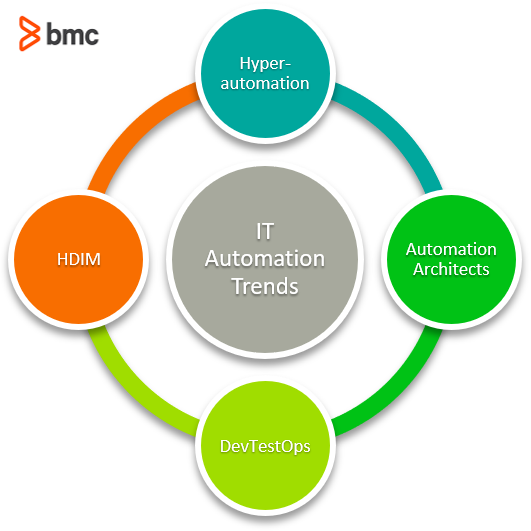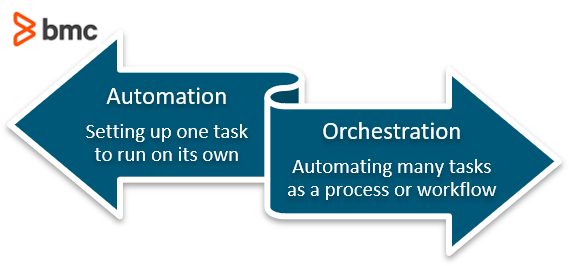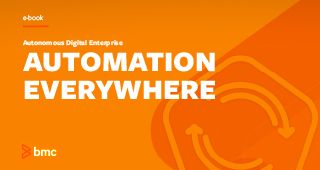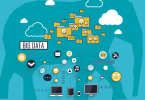Automation technologies overcome the static, manual nature of IT operations jobs that prevent successful digital transformation. The technologies manage infrastructure and operations (I&O) tasks based on business policies and resources. The goal is to establish an effective mechanism of automation within the dynamic settings of the IT environment, workforce resources, and the business landscape.
The enterprise IT industry and business organizations are evolving rapidly to address these changing requirements with novel technology solutions, practices, and trends. In this article, we will explore the latest technology trends in IT automation as an enabler to successful digital transformation (DX).
Enterprise IT today and tomorrow
Here’s a quick look into the recent Gartner predictions on IT automation shaping the current and future trends in the enterprise IT industry:
On hybrid IT and multi-cloud infrastructure:
- Organizations are readily adopting hybrid IT and multi cloud infrastructure capabilities. By 2021, over 75% of the organizations will have adopted these capabilities.
- 75% of all databases will operate in cloud infrastructure by the year 2023.
- 50% of all enterprise-generated data will be created and processed from off-site cloud environments.
- Most DX projects will cost twice as much and take twice as long as initially planned, at least until 2021.
On hyperautomation:
- 40% of all I&O teams will employ AI capabilities for scalable and agile IT Ops.
- The dedicated IT automation architect role, currently in 20% of organizations, will increase to 90% of organizations by the year 2025.
- By 2024, hyperautomation will reduce the cost of IT operations by 30%. Innovation will largely be driven by the motivation to reduce complexity in modern hybrid IT environments.
Now, let’s look at the trends.
Automation trends in 2021
Let’s discuss the three top trends, based on the current enterprise IT landscape, and explore what can make them instrumental components in your IT automation strategies:

1. A new role: Automation Architect
Support for multi-cloud and hybrid IT strategies is driving the adoption of IT automation technologies across the ITSM landscape. The unique and complicated service workflows involving a hybrid mix of cloud, on-site, and legacy IT infrastructure makes IT automation complicated itself. As a result, IT teams have adopted automation practices that are not standardized or scalable across business units.
While many organizations recognize the challenge, dedicated roles to architect IT automation strategies are not common among midsize firms. According to a recent research survey by Gartner:
- 20% of the organizations recognizing this requirement have employed dedicated Automation Architects.
- By 2025, this number will reach to more than 90% among large enterprises.
2. Hyperautomation challenges and HDIM
Companies are readily adopting AI/ML capabilities for end-to-end automation workflows and business processes. Traditionally, most automation solutions are designed to replace the manual process of resource provisioning and configurations, data management, and service management. The automated systems worked in silos, disconnected from the holistic business policies that must be adopted uniformly across the wider scope of IT Operations.
With the introduction of AI-driven hyperautomation capabilities, organizations are able to orchestrate autonomous operations within a complex hybrid IT environment. The AI technologies and the need to address automation challenges associated with a hybrid infrastructure have given rise to Hybrid Digital Infrastructure Management (HDIM), a unified technology driven management capability for hybrid infrastructure environments.

3. DevTestOps
QA has been a popular domain of IT automation, especially considering the vast scope of:
- Software testing
- Rising cybersecurity threats
- The business impact of software quality
Embracing the concepts of hyperautomation and the DevOps SDLC framework, QA is now increasingly adopting automation capabilities across end-to-end testing workflows. Continuous testing practices are fusing into DevOps workflows early during the SDLC pipeline with the goal of improving software quality.
The result, a combination of development, operations, and testing through collaborative efforts of appropriate teams, is known as DevTestOps. Automation remains a focus of continuous testing efforts not just for test repetitions but to improve the visibility of software quality through early and end-to-end testing.
The challenge of digital transformation
Finally, it’s important to understand that digital transformation is difficult. While technology adoption is inevitable, it doesn’t always translate into transformed business processes. The latter requires ongoing improvements across a variety of domains: talent acquisition, workforce culture, business requirements, and the market landscape, among others.
Organizations successful at digital transformation are able to align their initiatives of adopting digital technologies with the business value of automating IT processes and operations.
Of course, improving your company doesn’t stop with DX. Empowered by digital transformation, organizations can be on their A-game and evolve to become an Autonomous Digital Enterprise, a forward-looking vision of the future state of business that embraces intelligent, tech-enabled systems across every facet of the business to thrive during seismic changes.
Additional resources
For related reading, explore these resources:
- BMC Workload Automation Blog
- BMC Machine Learning & Big Data Blog
- 7 Ways to Put Automation Everywhere Into Practice for the Enterprise
- How AIOps Leads Digital Transformation
- State of AI in 2021
The Autonomous Digital Enterprise - Automation Everywhere
These postings are my own and do not necessarily represent BMC's position, strategies, or opinion.
See an error or have a suggestion? Please let us know by emailing blogs@bmc.com.







